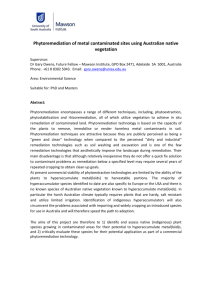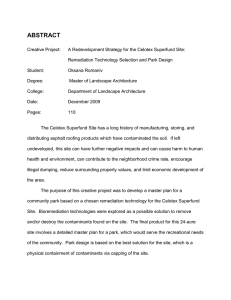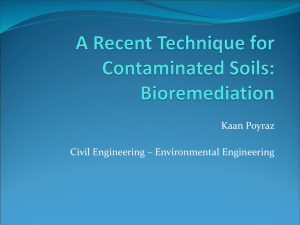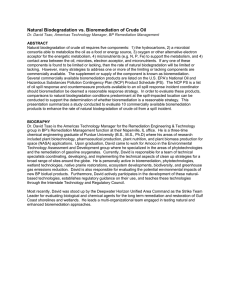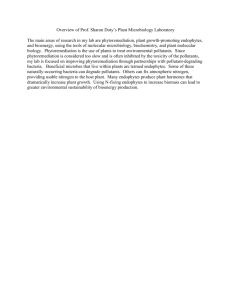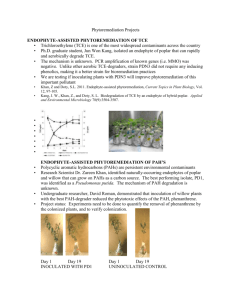Notes: Hazardous Waste
advertisement
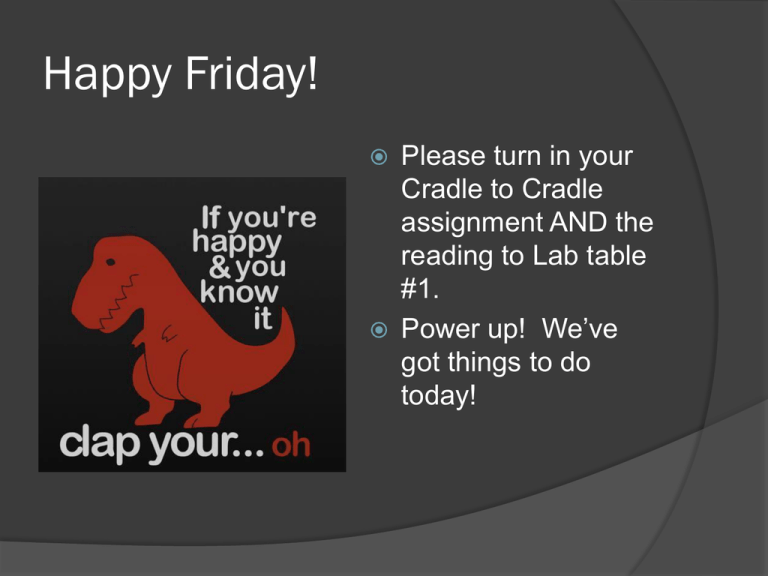
Happy Friday! Please turn in your Cradle to Cradle assignment AND the reading to Lab table #1. Power up! We’ve got things to do today! Full cost pricing: Full cost pricing = internal costs + external costs Internal costs – direct cost paid by consumer External costs – harmful social or environmental effect of production not included in market price of good Encouraging full cost pricing Economic incentives Subsidies for sustainable options (veg, not grain) Removing market barriers (Mining Law of 1872 - $5/acre) Ecolabeling programs (informed customer choice) Encouraging full cost pricing Economic disincentives Green taxes/effluent fees User fees for public resources Pollution prevention or assurance bond This weekend’s homework is on the HUB Find the hazardous waste notes on westsidewolves.org A little Love Story Love Canal Abandoned hydroelectric canal sold to Hooker Chemical Co. 22,000 tons 200+ chemicals including dioxins Wastes covered, site sold to Niagara Falls school board 1955 Love Canal Birth defects Dark liquids seeped into basements through walls Noxious chemical smells Trees and shrubs died Mid-1970’s heavy rains caused groundwater levels to rise Resident Louis Gibbs begins campaign to get authorities interested 1978 – EPA begins testing 1990 – massive cleanup began A recently discovered hazmat site: The San Jacinto Waste pits Paper mill wastes Paper mill wastes containing dioxins dumped in 1960’s and 70’s Land subsided, pits disappeared Crabs, fish have been showing high levels of dioxins and PCB’s for decades Dioxins biomagnify ; measured here at 70,000 parts per trillion; 95% of fish and crab dangerously contaminated “Dioxins can alter the fundamental growth and development of cells. In humans, adverse effects include suppression of the immune system, a variety of reproductive effects from reduced fertility to birth defects, chloracne, and cancer.” Dioxin limit in seafood: .47 pptrillion Catfish – 8pptrillion Blue crab – 6 pptrillion! So how did we let this happen? RCRA - Resource Conservation and Recovery Act of 1976 Required all landfills to be designed to “sanitary” standards Defined hazardous waste: (toxic, flammable, reactive, corrosive) Required cradle to grave management of hazmat 95% of materials are still “linguistically detoxified” Household hazardous wastes are not regulated So what do I do with batteries and CFLs? Houston South Hazardous Waste facility ESC South 11500 South Post Oak ZIP Code 77035 Harris county facility 6900 N Gessner/290 CFLs contain a small amount of Hg LEDs do not contain hazmat Compare Hazmat landfill to MSW landfill: Similarities? Differences? OK, but what about the wastes dumped before RCRA or illegally? CERCLA: Comprehensive Environmental Response, Compensation and Liability Act (Better known as Superfund) Identifies and prioritizes hazmat sites Seeks responsible parties for payment Remediates sites Superfund sites in Harris County EPA manages Superfund National Priorities list How can these sites be cleaned up? Mechanical remediation Phytoremediation Bioremediation Abandoned industrial or commercial sites. New owners must often clean up wastes before new development can begin Mechanical remediation Material incinerated and interred in haz waste landfill Can get down to deepest contamination Exposed soil (and contamination) may erode Phytoremediation Sunflowers – Lead Mulberry bush – industrial sludge Canola plants – selenium The trade offs of phytoremediation Less disturbance of area reduces risk of spreading contaminant Inexpensive Reduces material sent to landfill Can be slow acting Can only effect soil levels which roots can reach Must match plant to pollutant Animals could feed on plants – heavy metals could bioaccumulate Bioremediation Yeast, fungi, bacteria Digest organic compounds into CO2 and H2O Sites that are unable to be cleaned with microbes include those with high metal concentrations (i.e. mercury), highly chlorinated organics (compounds with many chlorine elements attached), and inorganic salts. These types of compounds are toxic to the microbes. Bioremediation ex situ What are the tradeoffs? Mechanical remediation Phytoremediation Bioremediation San Jacinto Waste pits - what are our options? Can you hear me now? toxic components in a pc Secret life of a cell phone National Geographic - High Tech Trash January 2008 Pairs Apply the concept of product of service to the e-waste dilemma What would manufacturers have to do to make this Product of Service idea a reality? Think it’s a pipe dream? Xerox – Solid ink – ships in block, no packaging, melts in copier Copiers designed to be disassembled when outdated. Components are refurbished and included in newer models where possible. Toner cartridges – returned to be refilled, not thrown out. Xerox “Before is was categorized as green, we thought of it as just being efficient.” –Ursula Burns, Xerox President “I’m in a funny business – I’m looking for ways that companies can print less. Printing is not going to go away, but we think you have to print more efficiently . . .We know that if we do that we can continue to grow.” – John Kelly, president of global services at Xerox Modular phones Note Check! How is bioremediation different from phytoremediation? How are bioremediation and phytoremediation similar? What is an advantage of mechanical remediation that might explain why it is the most common method used? List three toxic materials commonly found in ewaste. List two precious materials commonly found in ewaste. What objectives will be covered on the quiz tomorrow? When is the test on STUFF? When is the “complete the loop” extra credit due? When is the recycling picture assignment due?
